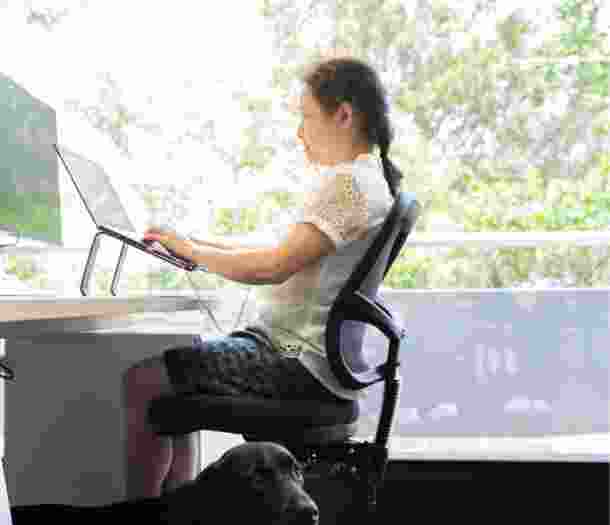This is a resource created by Clients, for Clients
We are the Assistive Tech Connect Crew. We are a group of Guide Dogs NSW/ACT Clients who have been learning how to use the Windows Screen Reader Narrator for the last 12 weeks.
We want to share with you some of the things we have learnt and break down any stigma around using screen readers. A screen reader converts text displayed on screen into ‘spoken synthesised speech’, which enables interaction with a range of computer applications. People who use screen readers use a range of keystrokes to operate the screen reader and navigate text.
During Assistive Tech Connect we have learnt how useful screen readers can be to help us achieve our goals – and that it wasn’t actually too hard to get started! We’d like to help others see just how achievable it is. In this resource we discuss some of the most useful keystrokes we have learnt to use Narrator, and share our top recommendations for getting started.
Let’s dispel one myth right upfront!
Screen readers are not just for people who are totally blind. They can be useful for people of any age who have low vision, experience visual fatigue, light sensitivity, dyslexia or any other difficulties reading and typing in text.
You may have heard of other screen readers such as, VoiceOver, JAWS or NVDA. In Assistive Tech Connect we have used the Windows Narrator screen reader because it is free and pre-installed on any Windows computer. Narrator is a great stepping-stone to more advanced screen readers.
Give Narrator a try!
It’s really easy to start up Narrator and start exploring your screen.
- To start Narrator from anywhere on your Windows computer, press keys: Control, Windows and Enter.
- Follow the prompts on screen to navigate through to the Narrator Homepage where you will find the Narrator tutorial. This will step you through all the Narrator essentials.
- To make many Narrator keystrokes work, you need to press the Caps Lock key in combination with other keys. We will call this the Narrator key from here on.
- It’s impossible to remember all the keystrokes you might need, which is why it is great you can press Narrator key and function key (F1) at any time to search for the Narrator keystroke you need.
- To get Narrator to start reading your screen continuously, press Narrator Key and R.
- To silence Narrator temporarily, press the Control key. Narrator will start talking again when you press another keystroke.
- To adjust the speaking rate of Narrator, press Narrator Key and plus (+) to make the synthetic speech faster or press Narrator key and minus (-) to make the synthetic speech slower.
- If you want to experiment with what keystroke combinations do what, enter input learning mode by pressing Narrator Key and the number one . You can then press any key or key combination to hear its function without it activating the key, or keystroke combinations, on the keyboard. To exit input learning mode, press Narrator and the number one again.
- On websites, Narrator enables you to jump from key elements really easily. You can press H or Shift with H to jump between headings. You can press K or Shift with K to cycle around the links on the page.
Make your Life Easier with Keystrokes
These are essential navigation keystrokes for anyone using a screen reader. Anyone can use them to make navigation faster, regardless if you are using a screen reader or not.
- Press Tab or Shift with Tab to navigate to the next and previous element on your screen.
- Use the Up or Down Arrow Keys to read the next and previous line of text.
- Use the Left or Right Arrow Keys to navigate to the next and previous character.
- Press Control and Left or Right Arrow Keys to navigate to the next or previous word.
- Press Control and Up or Down Arrow Keys to navigate to the next or previous paragraph.
- Press Home or End to move to the beginning or end of the line.
Our top tips for getting started
As well as learning some keystrokes, there are a few other things you will need to know:
- First of all, stick with it! Learning a screen reader takes persistence, patience and practice. And it pays off. It will get easier and easier.
- Don’t be daunted by all the keystrokes. It might seem overwhelming right now, but in time, you will learn the keystrokes you need and you will remember them. If you don’t, you can always double check them.
- You’ve probably heard proficient screen reader uses with the speech at a rate incomprehensible to the untrained ear. You might wonder how they can possibly understand it. Trust us, we wondered too, but the truth is, after time and exposure, you just get better and better at understanding synthesised speech. In time, you’ll get frustrated with the slowness of the speech and speed it up more and more.
- It can be easy to put off learning a screen reader until you can’t read anything on your screen. But we recommend learning before things get that hard. If you have a degenerative eye disease or there are other risks to your vision, it can really pay off to get ahead of the game and learn a screen reader. This way, you won’t be cut off from communication and information if you lose more sight. Having this skill can also allow you the space to focus on yourself and adjust if you lose more sight, without the stress of having to learn this new skill on top. .
Some technical things to remember
Some older Windows programs might not work so well with Windows Narrator. You might need to ensure all your Windows programs are up to date. If you run into strife, Guide Dogs NSW/ACT Assistive Technology Help Desk (AT Help Desk) can assist. Call 1800 436 364 and press option four. The Help Desk is open Monday to Friday 9.30 am to 12.30 pm. If you are outside NSW/ACT, contact Guide Dogs in your state and ask for help and advice.
If you are ready to learn more
The info in this guide was just the beginning, you can view the whole Narrator guide online.
About Assistive Tech Connect
Assistive Tech Connect is a 12-week program which provides an introduction to using screen readers on Windows computers. As well as the practical training, participants also benefit from mentorship and support from others who have made this transition before them. As a group program, participants also support and encourage one another. Assistive Tech Connect is a joint initiative between Connections Services and Assistive Technology Services at Guide Dogs NSW/ACT. The first intake and successful program was completed in 2022 in Newcastle.
In day-to-day life we are surrounded by helpful smart devices like Alexa and Google Assistant. But did you know that most devices have screen reading software that can turn your standard device into a smart device?
Resources
-
Download
Using a Screen Reader: Accessibility in Plain Sight
Ready to continue?
Seems like you have filled this form earlier. Let’s pick up where you left off.

